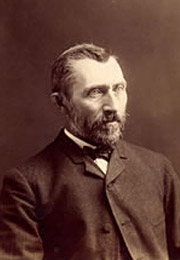The work of Vincent van Gogh (1853–1890) is inextricably linked to his fabled life, which epitomizes the romantic legend of the artist as a misunderstood and psychologically tormented genius. Although he famously sold only a single work over the course of his short but prolific career, Van Gogh developed a highly individualistic style of painting that was revered by subsequent generations of avant-garde painters, beginning with the Fauves and Expressionists.
Hailing from a Dutch family, his father a clergyman, Van Gogh left school to become an apprentice at an art dealership where a relative worked. From this vantage point, he learned about both Old Master and contemporary paintings while collecting contemporary British illustrations. Fired from his job in 1876, he was spurred by deep religious fervor to work as evangelist among miners in a downtrodden area of Belgium. His failure was apparent after just a few years, and in 1880, on the verge of a breakdown, he visited the artist Jules Breton, who inspired a new ambition of becoming a painter of peasants. Almost entirely self-taught, Van Gogh had only sporadic episodes of formal training.
Supported by his brother Theo, who was an art dealer, Vincent moved to Paris in 1886, and through Theo became acquainted with Impressionist artists. He soon adopted broken brushstrokes and vivid contrasts of complementary colors, particularly influenced by Georges Seurat’s pointillist innovations. Van Gogh was also deeply influenced by the expressive graphic devices of Japanese prints, which were then in fashion. He translated these elements into his own distinctive style, based on thick layers of impasto paint whose undulating rhythms captured a psychic intensity.
In early 1888, Van Gogh moved to the town of Arles in the south of France, drawn to the clarity of light, vivid colors of landscape, and rustic lifestyle. Hoping to create an artists’ community there, he was briefly joined by Paul Gauguin for an intense period of working together before a major falling-out. At the time, Van Gogh experienced a psychological breakdown that infamously resulted in the artist cutting part of his left ear. Committing himself to an asylum in Saint-Rémy for a year, Van Gogh continued work on views of the surrounding countryside as well as portraits, including a number of penetrating self-portraits. He spent his last months closer to Theo in Paris, under the care of Dr. Paul Gachet at Auvers-sur-Oise, where he continued to paint with great fervor. He was just beginning to receive favorable critical attention when he suffered another psychological attack and apparently shot himself in the chest, dying a few days later with Theo at his side. His copious illustrated letters to Theo and others, full of details about his life and art, were published posthumously and have contributed to both his fame and the biographical readings of his work.



